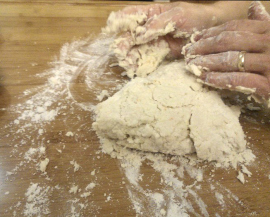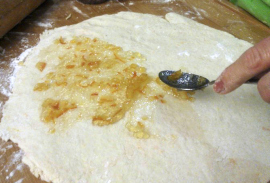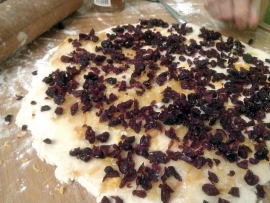Kathleen Flinn's Blog, page 28
March 7, 2012
Report from Paris: World Gourmand Awards
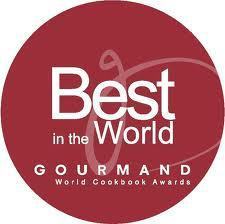 After a jet-lagged weekend visiting friends in London, Mike and I arrived in the City of Light on Tuesday to attend the Paris Cookbook Fair. The whole shebang began with the glittering The Gourmand Awards held this year at the deliciously gilded belle époque era theater, Les Folies Bergère. It's a glamorous affair, and on purpose. "I wanted to give [cookbooks] glamor," said Monsieur Edouard Cointreau, the founder of the Gourmand World Cookbook Awards, at the start of the evening's program. "Back when I started this 17 years ago, no one gave cookbooks much consideration."
After a jet-lagged weekend visiting friends in London, Mike and I arrived in the City of Light on Tuesday to attend the Paris Cookbook Fair. The whole shebang began with the glittering The Gourmand Awards held this year at the deliciously gilded belle époque era theater, Les Folies Bergère. It's a glamorous affair, and on purpose. "I wanted to give [cookbooks] glamor," said Monsieur Edouard Cointreau, the founder of the Gourmand World Cookbook Awards, at the start of the evening's program. "Back when I started this 17 years ago, no one gave cookbooks much consideration."
What's striking about the Gourmand Awards is the vastness of the competition, more than 30,000 books from 162 countries. When you're a finalist in that kind of company, it makes sense that 80 percent of the finalists actually make the trip to attend the awards event in Paris. In the course of two hours, people from at least four dozen countries as diverse as Peru, China, India, United States, Finland, Canada, Malaysia and St. Martin hit the stage to collect their awards.
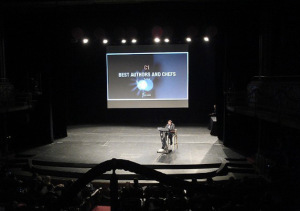 Equally spectacular is the presentation. Monsieur Cointreau sits on the stage narrating every aspect of the awards. He knows all the finalists intimately and can describe each entry in detail. He went beyond the names of the finalists, but also shared knowledge gleaned as one of the few people in the world with an enduring and encompassing view on the world of culinary publishing for 17 years. "In some categories, we have hundreds of books submitted so it's really not quite fair to compare them and come to four finalists," he told the crowd in the red velvet-paneled theater. "So anyone who makes the finals should be proud."
Equally spectacular is the presentation. Monsieur Cointreau sits on the stage narrating every aspect of the awards. He knows all the finalists intimately and can describe each entry in detail. He went beyond the names of the finalists, but also shared knowledge gleaned as one of the few people in the world with an enduring and encompassing view on the world of culinary publishing for 17 years. "In some categories, we have hundreds of books submitted so it's really not quite fair to compare them and come to four finalists," he told the crowd in the red velvet-paneled theater. "So anyone who makes the finals should be proud."
 The evening started with awards for wine books, a category that Cointreau noted is now one of the best sectors in culinary publishing, "with even better demand for them than cookbooks." You'd think that the French would dominate a wine category, but one of the intriguing notes to the evening was a striking number of American first places in this division, including See, Mix, Drink by Brian Murphy by US publisher Little Brown in the cocktail category; The Seasons of Veuve Cliquot by Stephanie Gerchel and Seasons of the Finger Lake Winery by John C. Hartsock ; The Food Lover's Guide to Wine by Karen Page and Andrew Dornenberg and The Oxford Companion to Beer by Horst Dornbusch.
The evening started with awards for wine books, a category that Cointreau noted is now one of the best sectors in culinary publishing, "with even better demand for them than cookbooks." You'd think that the French would dominate a wine category, but one of the intriguing notes to the evening was a striking number of American first places in this division, including See, Mix, Drink by Brian Murphy by US publisher Little Brown in the cocktail category; The Seasons of Veuve Cliquot by Stephanie Gerchel and Seasons of the Finger Lake Winery by John C. Hartsock ; The Food Lover's Guide to Wine by Karen Page and Andrew Dornenberg and The Oxford Companion to Beer by Horst Dornbusch.
In the past couple of years, the awards have included a prize for culinary apps, an area that Cointreau noted has a lot of interesting entries but still seems to be working itself out. The top spot went to the "Cooking with Dorie Greenspan" app, developed by Culinapp.
One of the evening's highlights was the award of Cookbook of the Year to a team led by Francisco Fantini from Chile for their book Patagonian Cuisine. The group of five hit the stage with shouts and high fives wearing matching racing jackets emblazoned with the name of their book on the back. In a passionate speech, one of the authors noted that while the book was about food, it was also a political move to encourage environmental and cultural respect for Patagonia. "We wanted to show this cuisine to save this area. A book is an everlasting message that has no borders."
U.S.-based celebrity chef, David Chang, took the stage next to claim the top prize for his quirky publication Lucky Peach in the magazine division. Clutching his red folder, he said simply, "Thank You, and Patagonia Free!"
Books focused on "easy recipes" make up about half of all books sold worldwide, Cointreau noted, making that category one of the most difficult to judge. The prize went to La Cuisine, a book packed with 1,000 simple French recipes, by Francoise Bernard, a 91-year-old legend in the French culinary world.
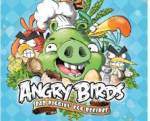 The first book category was won by seemingly the most improbable title on the whole program: The Angry Birds Cookbook (Finland).
The first book category was won by seemingly the most improbable title on the whole program: The Angry Birds Cookbook (Finland).
Cointreau noted a growing trend for vegetarian books worldwide. "It's an area of huge demand." One of the special awards of the evening went to Meat Free Monday by Paul, Stella and Mary McCartney. (Yes, that McCartney clan.) In one of the most surprising offhand tidbit of the evening, Cointreau noted that fund-raising, charity and community cookbooks are probably the most widely created and distributed forms of books worldwide, with thousands produced each year. "It's something that started in North America, but we've seen it blossom across the globe and now it's become arguably among the most difficult areas to win in these awards."
Of all the books mentioned in the evening, four of the winners in the other geographic region have now become the next food books I want to track down. They are: How to Cook a Crocodile by Bonnie Lee Black (Peace Corps Writers group), North America; Tibet, A Culinary Journey (China Tibetology Publishing); One Egg is a Fortune by Nina Jacobson and Judy Kempler; and Cook with Kids by Rob Kirby (Absolute Press). Books raising funds for refugees of the earthquake in Haiti took top prizes for the Caribbean entry.
 Oh, what memories flood back when I saw the flock of Le Cordon Bleu students pouring flutes and picking up glasses at the after party, each in their student uniforms; the girls still stuck with masculine tailoring, it seems. (Edouard is brother to Andre Cointreau, who owns the Le Cordon Bleu.) By then, it was midnight. As interesting as it all was, after 2 ½ hours, Mike and I realized we were drinking free champagne on an empty stomach, never a good plan. We had not located our tickets and instead of going to dinner, we went to the theater early in case we had to grovel for entrance, but it turned out our names were on the list. At that hour, we both knew that there was only one option in our minds, Au Pied de Cochon in Les Halles. We grabbed a taxi and finished the night with a couple bowls of their speciality, soup a l'oginon. The perfect way to end a culinary evening.
Oh, what memories flood back when I saw the flock of Le Cordon Bleu students pouring flutes and picking up glasses at the after party, each in their student uniforms; the girls still stuck with masculine tailoring, it seems. (Edouard is brother to Andre Cointreau, who owns the Le Cordon Bleu.) By then, it was midnight. As interesting as it all was, after 2 ½ hours, Mike and I realized we were drinking free champagne on an empty stomach, never a good plan. We had not located our tickets and instead of going to dinner, we went to the theater early in case we had to grovel for entrance, but it turned out our names were on the list. At that hour, we both knew that there was only one option in our minds, Au Pied de Cochon in Les Halles. We grabbed a taxi and finished the night with a couple bowls of their speciality, soup a l'oginon. The perfect way to end a culinary evening.
Check out the full summary of all the finalists and winners at the World Gourmand Awards site.








January 30, 2012
Recipe: Fabulous Scones Simple Enough for the Baking Challenged
 For years, my sister, Sandy, has been working to develop the perfect scone. It's a mission to satisfy a taste of home for her mother-in-law, Nora, a gentle woman born and raised in Ireland. Now 91, Nora grew up in an era when life was measured by what happened in between cups of tea and the most common form of entertainment was conversation, not watching television. "TV ruined the talk," she says in her sweet Irish brogue. About a dozen years ago, Sandy and Nora were in Michigan having tea in a bakery when they ordered a batch of scones. Nora just sighed. "If there's one thing I wish for, it's a good scone, like the ones my dear mother used to make." My sister never backs down from a challenge. Here's her recipe. The hands you see belong to her, working in her kitchen in St. Petersburg, Florida.
For years, my sister, Sandy, has been working to develop the perfect scone. It's a mission to satisfy a taste of home for her mother-in-law, Nora, a gentle woman born and raised in Ireland. Now 91, Nora grew up in an era when life was measured by what happened in between cups of tea and the most common form of entertainment was conversation, not watching television. "TV ruined the talk," she says in her sweet Irish brogue. About a dozen years ago, Sandy and Nora were in Michigan having tea in a bakery when they ordered a batch of scones. Nora just sighed. "If there's one thing I wish for, it's a good scone, like the ones my dear mother used to make." My sister never backs down from a challenge. Here's her recipe. The hands you see belong to her, working in her kitchen in St. Petersburg, Florida.
I'm a fan of this recipe for a number of reasons. It's easy enough for non-bakers, plus flexible enough for any taste. If you whip up a batch of these on a Sunday morning, you've got a lovely weekend treat, plus something to grab-and-go inexpensive breakfasts for the rest of the week. These keep best if left on the counter covered with a dish towel. They're good at room temperature, but warm up best in a low oven or toaster oven.
Sandy's Scones
Grating frozen butter into the batter and then chilling the completed dough again after mixing is the secret to a flaky, soft scone so don't skip this crucial step.
A great thing about scones is that they're flexible when it comes to flavoring. Try studding them with frozen blueberries, chopped peaches, chocolate chips, chopped apples, chopped dried figs, crushed almonds — the possibilities are endless. Just be sure not to use any fruit that's too wet such as fresh blueberries as that can introduce too much liquid into the dough and to thoroughly chill whatever you add in the freezer. You can also boost the flavor by spreading a light layer of jam or marmalade once the rolled out flour.
My sister uses fat-free milk and sour cream; I use low-fat as they tend to have less artificial ingredients. Yields about 15 scones.
8 tablespoons butter (1 stick), frozen
1 teaspoon of grated lemon or orange peel
2 cups white unbleached flour
¼ teaspoon baking soda
2 teaspoons baking powder
½ teaspoon salt
½ cup + 1 tablespoon sugar
½ cup low-fat milk
½ cup low-fat sour cream
1 egg, beaten
¼ cup dried cranberries
2 tablespoons orange marmelade
Before starting, put your butter in the freezer for at least 15 minutes. Preheat the oven to 425 F degrees. Then, grate the frozen butter with a cheese grater. Place it back in the freezer.
In a bowl, whisk the milk and sour cream together and then put into the fridge. Grate the skin off a lemon or orange into a large bowl. Add in the the flour, baking soda, baking powder, salt and ½ cup sugar and stir together. Lightly dust the countertop with flour.
Get the grated frozen butter and toss it with the flour mixture until all the butter is coated. Fold in the child milk and sour cream mixture and combine until the batter is quite wet. Turn out onto the floured countertop and with floured hands, knead it about six times. Do not over knead it.
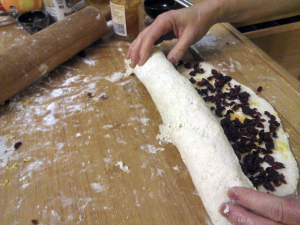
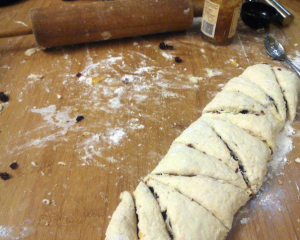 Roll the dough with a rolling pin into a 12-inch square. Fold it in half, and then fold again, like folding a napkin. Put it on a plate or similar and put into the freezer for about five minutes. This will rest the dough plus slightly refreeze the butter, yielding a more flaky pastry.
Roll the dough with a rolling pin into a 12-inch square. Fold it in half, and then fold again, like folding a napkin. Put it on a plate or similar and put into the freezer for about five minutes. This will rest the dough plus slightly refreeze the butter, yielding a more flaky pastry.
While its in the freezer, dust your countertop with flour again and put a heavy cookie sheet or baking stone into your preheated oven to get it warm. (You might want to use these few minutes to make yourself a cup of tea.)
After five minutes, remove the doll and roll your square flat into a 12-inch square. Push the dried cranberries into flattened batter, then spoon the marmalade into a light layer over top. Roll up the dough and turn it over if necessary so the seam is on the bottom. Gently push the roll down until it's about three inches wide.
With a sharp knife, cut the roll into a series of triangles. Brush the top with the beaten up and sprinkle lightly with the remaining sugar. Place the triangles on the preheated cookie sheet and bake for 15 minutes or until medium brown. Let the scones rest at least 15 minutes before serving.
You might also be interested in…
- GlutenFreeGourmand: Gluten-free scone recipe
- Jeanette's Healthy Living: Vegan/gluten-free cinammon-spiced scones








January 27, 2012
Upcoming Events
I've taken a little time off the blog while working on plans for not one, but two new books plus a couple of projects that you'll hear more about soon. Meanwhile, here's where I'll be going over the next few months.
Feb. 2nd: I'll be the keynote speaker at "Do Something Healthy" in Tacoma, Wash., a big annual event hosted by Multicare's Center for Healthy Living, who mission is to promote the health and wellness of its community by helping individuals to make healthy choices. Along with an evening talk by yours truly plus a cooking demo, you can get free health screenings and a great gift all for $10. Full details here.
March 6th-11th: Paris Cookbook Fair: It's my first time at the fair this year, and its our first trip back to Paris since 2008. I'll be reporting from the fair, so watch this space…
March 29th-April 2: International Association of Culinary Professionals annual conference in NYC: As a member of the board of directors, I've been busy helping to make this conference happen. I'm helping to plan the Culinary Book Fair at which I'll also be signing along with 75+ other food writers on Sunday, April 1st
Los Angeles Times Festival of Books: I'll be one of the authors speaking at this great annual event. Exact time, date and subject to come. Email, or watch this space.
I'm also taking my popular weekend food writing boot camp Hungry for Words on the road! We're working on dates and locations now, so if you're interested, drop us a line.








December 13, 2011
Recipe: Light Pumpkin Spice Cheessecake
 I don't like cheesecake. So often, it tastes simply of cream cheese and sugar, so rather than a guilty sense of pleasure, it leaves a cloying aftertaste in its wake. But my mother requested pumpkin cheesecake for Thanksgiving, so I reluctantly researched recipes. I got annoyed at recipes calling for up to a stick of butter or a cup of sugar to be added to a graham cracker crust. Seriously? Graham crackers already contain butter or oil and plenty of sugar. After a few trials, I used just three tablespoons of butter and added a bit of agave syrup to hold it all together.
I don't like cheesecake. So often, it tastes simply of cream cheese and sugar, so rather than a guilty sense of pleasure, it leaves a cloying aftertaste in its wake. But my mother requested pumpkin cheesecake for Thanksgiving, so I reluctantly researched recipes. I got annoyed at recipes calling for up to a stick of butter or a cup of sugar to be added to a graham cracker crust. Seriously? Graham crackers already contain butter or oil and plenty of sugar. After a few trials, I used just three tablespoons of butter and added a bit of agave syrup to hold it all together.
The filling incorporates soft tofu in place of one of the cream cheese packages, a tip from vegan recipes. But most recipes call for cup of white sugar, which struck me as excessive. So I cut back on the sweet factor, opted for agave syrup and brown sugar and kicked up the spice quotient. The result? Lighter than either pumpkin pie or traditional cheesecake yet with the same holiday flavor with significantly less sugar and fat.
 I try to cut back on hydrogenated oils at every turn and HoneyMaid, the leading graham cracker brand uses the dreaded partially hydrogenated cottonseed oil, so if you can find them, try the ones from Back to Nature Foods. Simply smash them in a plastic bag with the bottom of a heavy saucepan or pulse in a food processor. If you don't have pumpkin pie spice, simply use a blend of cinnamon, nutmeg and ground cloves.
I try to cut back on hydrogenated oils at every turn and HoneyMaid, the leading graham cracker brand uses the dreaded partially hydrogenated cottonseed oil, so if you can find them, try the ones from Back to Nature Foods. Simply smash them in a plastic bag with the bottom of a heavy saucepan or pulse in a food processor. If you don't have pumpkin pie spice, simply use a blend of cinnamon, nutmeg and ground cloves.
Crust
1 ½ cups of graham cracker crumbs
¼ cup (3 tablespoons) melted unsalted butter
2 tablespoons agave syrup, honey or maple syrup
Filling
1 16 oz. package silky or soft tofu
1 8 oz. package cream cheese
1 15 oz. can pumpkin puree (about 1 ½ cups)
¼ cup (3 tablespoons) agave syrup or honey
¼ cup (3 tablespoons) brown sugar
2 teaspoons pumpkin pie spice
Pinch of salt
3 eggs
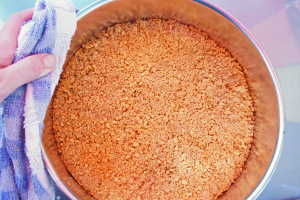 Preheat oven to 325 degrees. Combine the cracker crumbs, butter and syrup or honey in a bowl and blend with a spoon or fingers until they're moist. Press into the bottom of a tart pan or spring-form mold and bake in the oven for about 15 minutes. Let cool before adding the filling or else the heat from crust and pan will start to cook the filling; you can pop the whole pan into freezer to accelerate the cooling process. You can do this a day prior, too; just store the shell in the fridge.
Preheat oven to 325 degrees. Combine the cracker crumbs, butter and syrup or honey in a bowl and blend with a spoon or fingers until they're moist. Press into the bottom of a tart pan or spring-form mold and bake in the oven for about 15 minutes. Let cool before adding the filling or else the heat from crust and pan will start to cook the filling; you can pop the whole pan into freezer to accelerate the cooling process. You can do this a day prior, too; just store the shell in the fridge.
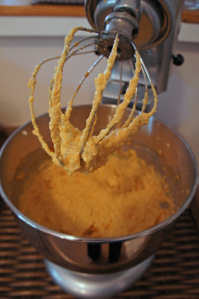 Drain the tofu and crumble into a colander to drain off excess liquid. Blend the tofu, cream cheese, pumpkin puree, syrup or honey, sugar, spice and salt together in a large bowl and using a mixer or hand-held blender or food processor. Taste. If you want it sweeter or spicier, add more sugar or spice. The batter won't look exactly smooth as the tofu will keep it a bit lumpy, so just blend it enough to get it consistency like small curd cottage cheese. Add the eggs one at a time and blend each one thoroughly into the batter. Pour the batter onto the cooled crust and bake for about 50 minutes to one hour or until the batter firms up and the edges brown slightly and start to come away from the sides of the pan. Let cool, then put into a refrigerator for at least four hours. It can be made up to two days in advance of serving.
Drain the tofu and crumble into a colander to drain off excess liquid. Blend the tofu, cream cheese, pumpkin puree, syrup or honey, sugar, spice and salt together in a large bowl and using a mixer or hand-held blender or food processor. Taste. If you want it sweeter or spicier, add more sugar or spice. The batter won't look exactly smooth as the tofu will keep it a bit lumpy, so just blend it enough to get it consistency like small curd cottage cheese. Add the eggs one at a time and blend each one thoroughly into the batter. Pour the batter onto the cooled crust and bake for about 50 minutes to one hour or until the batter firms up and the edges brown slightly and start to come away from the sides of the pan. Let cool, then put into a refrigerator for at least four hours. It can be made up to two days in advance of serving.
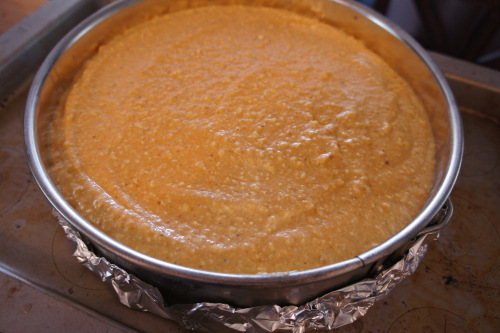 Before serving, as a garnish, sprinkle the top with brown sugar, powdered sugar or a very light coating of nutmeg along the top. (The easiest way to do this is to put a small amount into a mesh sieve and wave over the top.) If you're the type who likes nuts on their cheesecake, you can also garnish with candied walnuts, pecans or similar. Of course, a dab of freshly whipped cream is universally well loved.
Before serving, as a garnish, sprinkle the top with brown sugar, powdered sugar or a very light coating of nutmeg along the top. (The easiest way to do this is to put a small amount into a mesh sieve and wave over the top.) If you're the type who likes nuts on their cheesecake, you can also garnish with candied walnuts, pecans or similar. Of course, a dab of freshly whipped cream is universally well loved.
You might also be interested in:
- Smitten Kitchen: How to make your own graham crackers
- Confections of a Foodie Bride: Pumpkin cheesecake brownies
- To Live and Eat in LA: Vegan pumpkin cheesecake
- Elena's Pantry: Gluten-free cinammon cheesecake








December 2, 2011
We Didn’t Miss the Turkey
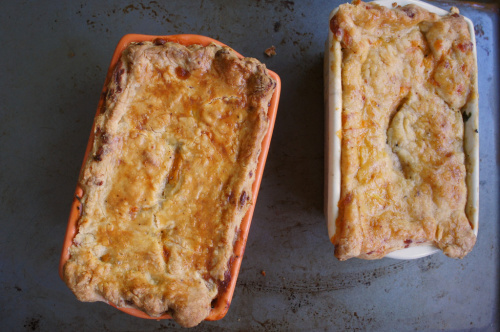 I just realized that I’ve not yet provided a full report on our first vegetarian Thanksgiving. To start, the vegetable pot pie recipe from Kim O’Donnel’s great book The Meat Lover’s Meatless Cookbook were such a hit that Mike thinks they should become an annual tradition. My sister made her first batch of stuffing with thyme-spiked vegetable stock instead of turkey stock, then studded it with cranberries, walnuts and roasted vegetables. Honestly, it was some of the best stuffing she’s ever made.
I just realized that I’ve not yet provided a full report on our first vegetarian Thanksgiving. To start, the vegetable pot pie recipe from Kim O’Donnel’s great book The Meat Lover’s Meatless Cookbook were such a hit that Mike thinks they should become an annual tradition. My sister made her first batch of stuffing with thyme-spiked vegetable stock instead of turkey stock, then studded it with cranberries, walnuts and roasted vegetables. Honestly, it was some of the best stuffing she’s ever made.
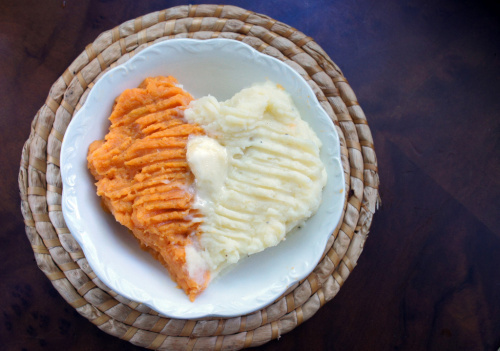 For me, the holidays are all about the mashed potatoes and gravy. My niece Sarah won’t eat mushrooms, so I gently coaxed three large sweet onion to caramelize to a mahogany color and used them in a recipe similar to this one. I didn’t have any arrowroot to thicken it, and I don’t like the flavor of cornstarch. In a moment of inspiration, I took some oatmeal and pulverize it in the coffee grinder that I set aside for herbs. Voila! Instantly thickened gravy.
For me, the holidays are all about the mashed potatoes and gravy. My niece Sarah won’t eat mushrooms, so I gently coaxed three large sweet onion to caramelize to a mahogany color and used them in a recipe similar to this one. I didn’t have any arrowroot to thicken it, and I don’t like the flavor of cornstarch. In a moment of inspiration, I took some oatmeal and pulverize it in the coffee grinder that I set aside for herbs. Voila! Instantly thickened gravy.
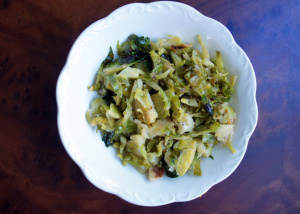 I’ve started to use the caramelized shallot butter from Fine cooking that we put on the roasted brussel sprouts for everything. That stuff’s addictive.
I’ve started to use the caramelized shallot butter from Fine cooking that we put on the roasted brussel sprouts for everything. That stuff’s addictive.
So, now I’m contemplating Christmas Eve dinner and Christmas Day dinner. We’ll have carnivore friends visiting us for the holiday. I’m eyeing the chard and lentil shepard’s pie, another dish from Kim O’Donnel’s book. I can always make a traditional one with beef. That should satisfy everyone, right?
Onion Herb Gravy
The stock determines whether this is vegetarian and the final flavor; traditional English gravies use beef stock. Use oil in place of butter along with vegetable stock to make it vegan-friendly. The onions can be caramelized a couple of days in advance; caramlized onions can also be frozen and make a great addition to virtually any savory dish.
If using a thin vegetable stock, the resulting gravy may need a boost to hit your desired thickness. Add a bit of any traditional thickener, such as arrowroot, potato starch, Wondra, tapioca or cornstarch or try my handy trick of whizzing some oatmeal in a coffee grinder. Be careful and add only a teaspoon at a time and whisk well to avoid creating lumps.
2 large sweet onions, such as Vidalia
2 tablespoons vegetable oil
1 bay leaf
1 1/2 tablespoon butter or vegetable oil
1 1/2 tablespoon flour
3 cups stock (vegetable, mushroom, poultry or beef)
1 teaspoon dried thyme
1/2 teaspoon dried sage
Coarse salt, black pepper
Thinly slice the onions. Add oil to a large skillet over medium-high heat and add the onions and bay leaf. Stirring regularly, saute the onions for about 10 minutes, adding splashes of water as needed to keep from sticking to the bottom of the pan. After 10 minutes, reduce the heat to medium-low and stir from time to time until the onions are a deep brown color, about 35 minutes.
When ready to make the gravy, melt the butter in a saucepan over medium-high heat. Make a roux by adding the flour and whisk to incorporate and lightly cook the flour until it smells like popcorn. Add the stock and bring to gentle boil while whisking. Add the onions, bay leaf, thyme, a couple pinches of salt and a few grinds of coarse pepper. Simmer for about 10 minutes. Spoon off any foam or fat that rises to the surface. Taste. Add more salt and pepper until it reaches the flavor you want. Remove the bay leaf before serving.








We Didn't Miss the Turkey
 I just realized that I've not yet provided a full report on our first vegetarian Thanksgiving. To start, the vegetable pot pie recipe from Kim O'Donnel's great book The Meat Lover's Meatless Cookbook were such a hit that Mike thinks they should become an annual tradition. My sister made her first batch of stuffing with thyme-spiked vegetable stock instead of turkey stock, then studded it with cranberries, walnuts and roasted vegetables. Honestly, it was some of the best stuffing she's ever made.
I just realized that I've not yet provided a full report on our first vegetarian Thanksgiving. To start, the vegetable pot pie recipe from Kim O'Donnel's great book The Meat Lover's Meatless Cookbook were such a hit that Mike thinks they should become an annual tradition. My sister made her first batch of stuffing with thyme-spiked vegetable stock instead of turkey stock, then studded it with cranberries, walnuts and roasted vegetables. Honestly, it was some of the best stuffing she's ever made.
 For me, the holidays are all about the mashed potatoes and gravy. My niece Sarah won't eat mushrooms, so I gently coaxed three large sweet onion to caramelize to a mahogany color and used them in a recipe similar to this one. I didn't have any arrowroot to thicken it, and I don't like the flavor of cornstarch. In a moment of inspiration, I took some oatmeal and pulverize it in the coffee grinder that I set aside for herbs. Voila! Instantly thickened gravy.
For me, the holidays are all about the mashed potatoes and gravy. My niece Sarah won't eat mushrooms, so I gently coaxed three large sweet onion to caramelize to a mahogany color and used them in a recipe similar to this one. I didn't have any arrowroot to thicken it, and I don't like the flavor of cornstarch. In a moment of inspiration, I took some oatmeal and pulverize it in the coffee grinder that I set aside for herbs. Voila! Instantly thickened gravy.
 I've started to use the caramelized shallot butter from Fine cooking that we put on the roasted brussel sprouts for everything. That stuff's addictive.
I've started to use the caramelized shallot butter from Fine cooking that we put on the roasted brussel sprouts for everything. That stuff's addictive.
So, now I'm contemplating Christmas Eve dinner and Christmas Day dinner. We'll have carnivore friends visiting us for the holiday. I'm eyeing the chard and lentil shepard's pie, another dish from Kim O'Donnel's book. I can always make a traditional one with beef. That should satisfy everyone, right?
Onion Herb Gravy
The stock determines whether this is vegetarian and the final flavor; traditional English gravies use beef stock. Use oil in place of butter along with vegetable stock to make it vegan-friendly. The onions can be caramelized a couple of days in advance; caramlized onions can also be frozen and make a great addition to virtually any savory dish.
If using a thin vegetable stock, the resulting gravy may need a boost to hit your desired thickness. Add a bit of any traditional thickener, such as arrowroot, potato starch, Wondra, tapioca or cornstarch or try my handy trick of whizzing some oatmeal in a coffee grinder. Be careful and add only a teaspoon at a time and whisk well to avoid creating lumps.
2 large sweet onions, such as Vidalia
2 tablespoons vegetable oil
1 bay leaf
1 1/2 tablespoon butter or vegetable oil
1 1/2 tablespoon flour
3 cups stock (vegetable, mushroom, poultry or beef)
1 teaspoon dried thyme
1/2 teaspoon dried sage
Coarse salt, black pepper
Thinly slice the onions. Add oil to a large skillet over medium-high heat and add the onions and bay leaf. Stirring regularly, saute the onions for about 10 minutes, adding splashes of water as needed to keep from sticking to the bottom of the pan. After 10 minutes, reduce the heat to medium-low and stir from time to time until the onions are a deep brown color, about 35 minutes.
When ready to make the gravy, melt the butter in a saucepan over medium-high heat. Make a roux by adding the flour and whisk to incorporate and lightly cook the flour until it smells like popcorn. Add the stock and bring to gentle boil while whisking. Add the onions, bay leaf, thyme, a couple pinches of salt and a few grinds of coarse pepper. Simmer for about 10 minutes. Spoon off any foam or fat that rises to the surface. Taste. Add more salt and pepper until it reaches the flavor you want. Remove the bay leaf before serving.








November 22, 2011
Our first vegetarian Thanksgiving
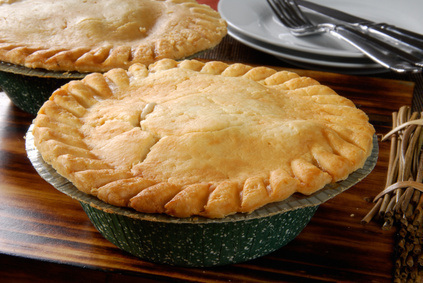 As promised, here's the plan for our Thanksgiving dinner this Thursday. It's subject to change, of course, once my sister Sandy gets involved, not to mention that I'm notoriously fickle about following recipes. But it's kind of a big deal as its the first time in the history of my family that we've had a vegetarian Thanksgiving.
As promised, here's the plan for our Thanksgiving dinner this Thursday. It's subject to change, of course, once my sister Sandy gets involved, not to mention that I'm notoriously fickle about following recipes. But it's kind of a big deal as its the first time in the history of my family that we've had a vegetarian Thanksgiving.
Yes, me, the woman who spent a year at Le Cordon Bleu stuffing meat into other meat and who has deboned and dismembered entire turkey for the past five years will be making a completely vegetarian menu. A couple of months ago, Mike and I watched the documentary Forks Over Knives. The gist: medical research increasingly shows that people with diets high in meat and dairy tend to be the most likely to suffer from obesity, diabetes, cancer and cardiovascular disease. This isn't exactly breaking news, but the film focuses on an extensive labor of research known as The China Study. Mike and I had already started cutting our meat consumption already, but after watching the film, we made a pact to keep it to less than 10 percent.
Coincidentally, my mother and stepdad watched the film around the same time and came to the same conclusion. My mother went on a mission to get everyone in our extended family to watch it, and thus it's been a domino effect resulting in all the people who will be seated at our Thanksgiving table this year didn't want a turkey.
Most of my meat eating these days comes when eating out, as often the vegetarian options on menu seem lacking (or non-existant) and sometimes it's just socially awkward. Plus, as a food writer, it's sometimes part of my job to eat or try certain things.
But this new habi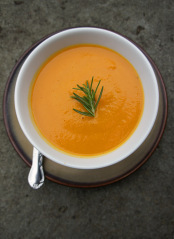 t has altered my perspective. For example, I never noticed that most restaurants include meat on every single menu item, including salads. I got into a protracted discussion with a hotel restaurant manager in Los Angeles while on book tour after I asked about vegetarian options and the server brought me a kids menu since it offered spaghetti with marinara sauce (from a can) and mac and cheese, their only non-meat options.
t has altered my perspective. For example, I never noticed that most restaurants include meat on every single menu item, including salads. I got into a protracted discussion with a hotel restaurant manager in Los Angeles while on book tour after I asked about vegetarian options and the server brought me a kids menu since it offered spaghetti with marinara sauce (from a can) and mac and cheese, their only non-meat options.
It's discouraging to see the wide swath of real estate devoted to meat in my supermarket here in Florida, only to see the organic vegetable and tofu ghetto stuffed into a dark corner of the produce section. (The stocker I talked to said he's "always restocking the tofu" since they sell a lot of it.)
This doesn't mean that I'll never write another recipe with meat, or that I'll never roast another chicken or anything like that. But I think everyone could use shaking up the foundations of their diet and routines every now and then, don't you?
With that, here's the basic plan with another vegetable side (or two) to come from my sister. I'll be sharing what I'm making as we go on Twitter, if you'd like to follow along.
Main dish
Vegetable pot pie with cheddary biscuit crust courtesy The Meat Lover's Meatless Cookbook by Kim O'Donnel
Appetizers
Mushroom and lentil pate
Pumpkin gyoza (by White On Rice)
Carrot and rosemary soup (photo above)
Sides
Mashed potatoes and parsnips (inspired by What Would Cathy Eat?)
Baked sweet potatoes
Caramelized onion gravy (similar to this one from Sweet Bean and Green)
Porcini, apple and sage stuffing (inspired by Two Peas and their Pod)
Mom's cranberry and orange relish (similar to Elise's at Simply Recipes)
Roasted Brussels sprouts with shallot butter (from my friends at Fine Cooking )
Green bean casserole with fresh green beans and my version of mushroom soup (recipe to come)
Desserts
Five-spice pumpkin tofu cheesecake (an adaptation from Relish mag)
Roasted apple and pear tart on a whole wheat crust
We also have a meyer lemon tree in our yard, so I'm looking for a healthy-ish lemon cream pie recipe. Anyone got one?








November 21, 2011
A few tips to be fearless this Thanskgiving
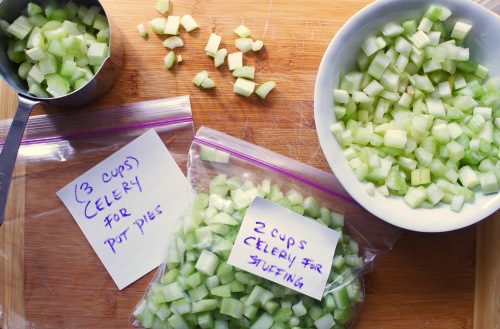 Holiday meals can cause even confident cooks a great deal of performance anxiety. Here are a few Le Cordon Bleu-style tips for making the whole thing go easier:
Holiday meals can cause even confident cooks a great deal of performance anxiety. Here are a few Le Cordon Bleu-style tips for making the whole thing go easier:
Get your chef's knife sharpened. If you've got a good chef's knife, take it in to get it sharpened ahead of the big meal. Some options: Most Sur La Table outlets, cutlery shops, good local hardware stores and even restaurant supply outlets. Don't have a decent chef's knife? Maybe it's time for an early holiday gift for yourself. This is a good time to sharpen your knife skills.
Mise en place. In French, this loosely translates to "everything in place," and it's a common chef's strategy for kitchen efficiency. Basically, it means get as much prepped as possible before cooking. In my house, I do most of the peeling, chopping and measuring of ingredients a night or two prior to cooking; simply put chopped stuff into storage bins or bags and mark them as needed. (Above photo.) You can even measure out ingredients for each recipe ahead of time, right down to spices. (Tip: Use little Dixie cups.) Put them all together with a photocopy or printout of the recipe. The next day, it's not only a simple assembly job, it's also a great place to steer that relative who arrives midday and says, "Can I help?" Now they can, without bothering you every couple of minutes to ask where you keep various items. Note: The one exception I make are potatoes for mashing. While you can store peeled potatoes in water overnight, they keep their color and taste better when freshly peeled.
Butter trick. Take sticks of butter and cut them into one tablespoon squares and set inside your fridge in a bowl. All the pros do this.
Hold food over steam, not just in the oven. One of the hardest thing for home cooks putting on a big meal is getting everything hot to the table at once. Most people hold things to keep them hot in the oven, but then that space becomes a premium if it's still being employed, can overcook food. So, instead, think about those long steam tables at buffets and fill a few pans with water, heat it up, then place your serving bowl or pan in the hot water, cover it with a lid, foil or heat-resistant plastic wrap. Have more food than burners? I keep a couple of trivets near the stove and rotate the foods around as more food finishes as mealtime approaches.
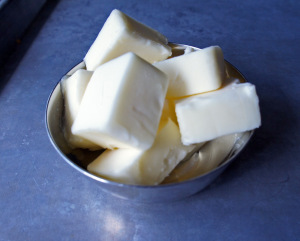
If temperature friendly outside, use your grill. It can act as an extra burner.
Set your table the night (or even two) days before. Restaurants make sure all their tables are set for the next service. This includes making sure water pitchers are ready for filling, corkscrews are nearby for wine, water glasses are in place and so on. If you're going to serve coffee, make sure you've got the coffee cups and set up the coffee ahead of dinner to be ready at dessert.
Inventory your service wear. Set out your serving bowls and serving utensils two days ahead of time. This is particularly important if you're new to entertaining. Write out your menu, then pull down the dish you plan to serve it in from the turkey platter to whatever you're serving butter for the rolls on, plus every single utensil you need. Put a post-it note on each item and leave them out if you can. In most cases, "missing" items can easily be borrowed. It's better to know ahead of time than freaking at the last-minute that you didn't think about a ladle for the gravy. Also, I can't stress how valuable little tongs and pie servers are when hosting a big dinner.

Out of counter space? Go vertical. Professional kitchens employ vertical racks known as "speed racks." Depending on your kitchen, consider clearing out a cupboard hoarding cereals and pantry items and set it into a box in a bedroom so that you can use that area for extra space to set finished dishes, pies or collect all your mise en place while you're cooking. (While you're putting it back, go through the box and see what you've not used in the past six months and consider donating it to a food bank.)
Be safe. Ask everyone in your kitchen to wear shoes with closed toes while cooking; in the unusual activity and chaos that can occur in a kitchen, hot gravy or even a knife can fall unexpectedly and cause injury. Be sure you've got good oven mitts or invest in some cloth diapers and keep them handy and dry as anything even moist can transmit heat and cause burns. Keep handwash and paper towels near the sink and be sure everyone washes hands frequently, not just after touching the turkey. Keep counters clear of debris and avoid stacking anything perilously on counters.
Have a plan for the dishes. If you're using separate dishes for dessert, stack them near the table. Count silverware to assure you've got enough, or set up a bowl with hot soapy water for a quick cleaning between courses. For years, I've employed a laundry basket or recycling bin as a bus tub. As dishes are gathered, they're stacked in the tub along with non-fragile glassware (such as wine glasses), and set aside until ready for cleaning; the tub can even be set in another room or on the floor. They're safe, out of the way and it eliminates the "immediacy" of having to race to immediately clean up.
Be realistic in your expectations, and forgive yourself if something doesn't work out. Remember, Julia Child suggested that you avoid apologizing for anything you felt went wrong in the kitchen. So you cooked the green beans too long, or your pie doesn't look like the picture. So what? No one is going to tell you to pack your knives go home. It's Thanksgiving, and all you should do is give thanks for the good stuff in your life, and pack up the rest with the rest be leftovers.








November 2, 2011
Few Good Food Links: Unprocessed October, Healthy Thanksgiving, Reviews
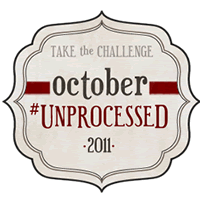 I offered a guest post (a recipe for baked chicken nuggets) for Andrew Wilder's Eating Rules "October Unprocessed," a challenge to completely avoid processed food for a month. (Disclosure: I did fairly well, but did resort to sandwiches made with processed bread and a few granola bars while on book tour…) His effort resulted in 31 days of great tips and tactics for freeing yourself form the generalized tyranny of convenience foods.
I offered a guest post (a recipe for baked chicken nuggets) for Andrew Wilder's Eating Rules "October Unprocessed," a challenge to completely avoid processed food for a month. (Disclosure: I did fairly well, but did resort to sandwiches made with processed bread and a few granola bars while on book tour…) His effort resulted in 31 days of great tips and tactics for freeing yourself form the generalized tyranny of convenience foods.
In a similar vein over at What Would Cathy Eat?, Cathy Elton has laid down another challenge: a Heatlhy Thanksgiving. Several of my family members have cut down our meat consumption (more on that in another post), so this year Mike and I decided it's time for a vegetarian Thanksgiving.
Yes, you read that right. No deboned whole turkey, no heavily buttered white potato gratins. See, I've got this thing. I love my husband. He has some not-nice family history with heart disesase and didn't score so great on a modern medical-style peek at his arteries, so we both agreed recently to cut back our meat and dairy consumption. But his first question was, "Well, when I don't eat meat, what can I eat?" As it turns out, plenty.
I think that's why I like Cathy's site. After a heart condition led her doctor to recommend a bland diet - to which she responded, if memory serves, "No fucking way" – she overhauled her diet and proves that eating well doesn't mean giving up great food or flavor.
It has always struck me as odd that we celebrate one of the most Puritan of holidays with one of the deadly sins (gluttony). Last year, I gained 10 pounds between mid-November and January 1st. I'm height-challenged at 5'3", so while that gain might make some people's jeans tight, it made it impossible to wear most of my clothes. I've decided this year, I don't want to go there.
So, who's with me? I'm not saying you have to give up the bird, but perhaps don't wrap it in bacon, avoid the boxed stuffing, try to cut some of the calories out of that pumpkin pie and up your offering of vegetables. (See all of Cathy's tips.) I'm going to post recipes as I find them, so if you know of some great options (including your own), let me know. I'll even be hosting an online chat the week of Thanksgiving to answer questions and share what I've decided to make. If you're on Twitter, follow the hashtag #healthythanks
Other links:
In an embarssment of riches in terms of great coverage, here are a few of the best written reviews of the The Kitchen Counter Cooking School: The Cleveland Plain Dealer, The Wall Street Journal and Associated Press (it appeared all over, but here it is on the Today show site). Thanks for the kind and well thought-out words. I'm compiling a list of all the reviews in the next couple of weeks — when I get a chance to catch my breath.
Chow Bella: I think that the folks behind the food section at New Times in Phoenix is on to something. They developed an online book club that paired with local bookstore Changing Hands to offer a discount on their selection. I'm deeply honored they selected my book as their first, especially since it prompted my publisher, Viking/Penguin to hastily add another tour date to send me there (as I write this, tomorrow). But it reminds me that even in an age-old industry as newspapers and bookstores, there's always a new way to do what both mean to do: engage people and bring them together. It's also made me think, maybe more authors should start online book clubs? I have so many books that I read that I think deserve an audience, plus I love books (especially books about food) and I adore talking about them. Stay tuned.
[image error]







October 25, 2011
New "Energy Star" style ratings for food?
 As anyone familiar with my new book knows, I've developed a habit of following people at supermarkets, and sometimes I talk to them. (Someone on my book tour said this is known as "action research" by behavior scientists. I prefer it to "stalking.") A medical watchdog group is proposing the adoption of "Energy Star" style labels for foods to help battle the confusion caused by existing nutritional labels. I think this is a great idea, but I suspect that a lot of food manufacturers will fight it. They're the ones who have been telling us for years that sugar-loaded cereals are "part of a complete breakfast." CBS News reports:
As anyone familiar with my new book knows, I've developed a habit of following people at supermarkets, and sometimes I talk to them. (Someone on my book tour said this is known as "action research" by behavior scientists. I prefer it to "stalking.") A medical watchdog group is proposing the adoption of "Energy Star" style labels for foods to help battle the confusion caused by existing nutritional labels. I think this is a great idea, but I suspect that a lot of food manufacturers will fight it. They're the ones who have been telling us for years that sugar-loaded cereals are "part of a complete breakfast." CBS News reports:
Registered dietician Samantha Heller said the changes being proposed by the Institute of Medicine are akin to the Energy Star ratings for appliances.
The front of the package would feature a check mark or star markings and the calorie count. The back of the package would have the traditional nutrition facts table. Currently, Heller explained, consumers get mixed messages when it comes to labeling. She said, "A package can say 'high in fiber,' 'a good sourse of calcium' and be high in saturated fat or sodium. Consumers aren't sure what they are getting, and it's very frustrating. … (The Institute of Health's labels) are looking at calories and then evaluating saturated and trans fat, sodium, and added sugars. If you meet their criteria, you get a check mark for each, or a star. They are still working on this. It's a work in progress, it's an enormous undertaking, and food and nutrition is very complicated."
Watch the full video report over at CBS News or read the full report online at the Institute of Health.





 [image error]
[image error]


